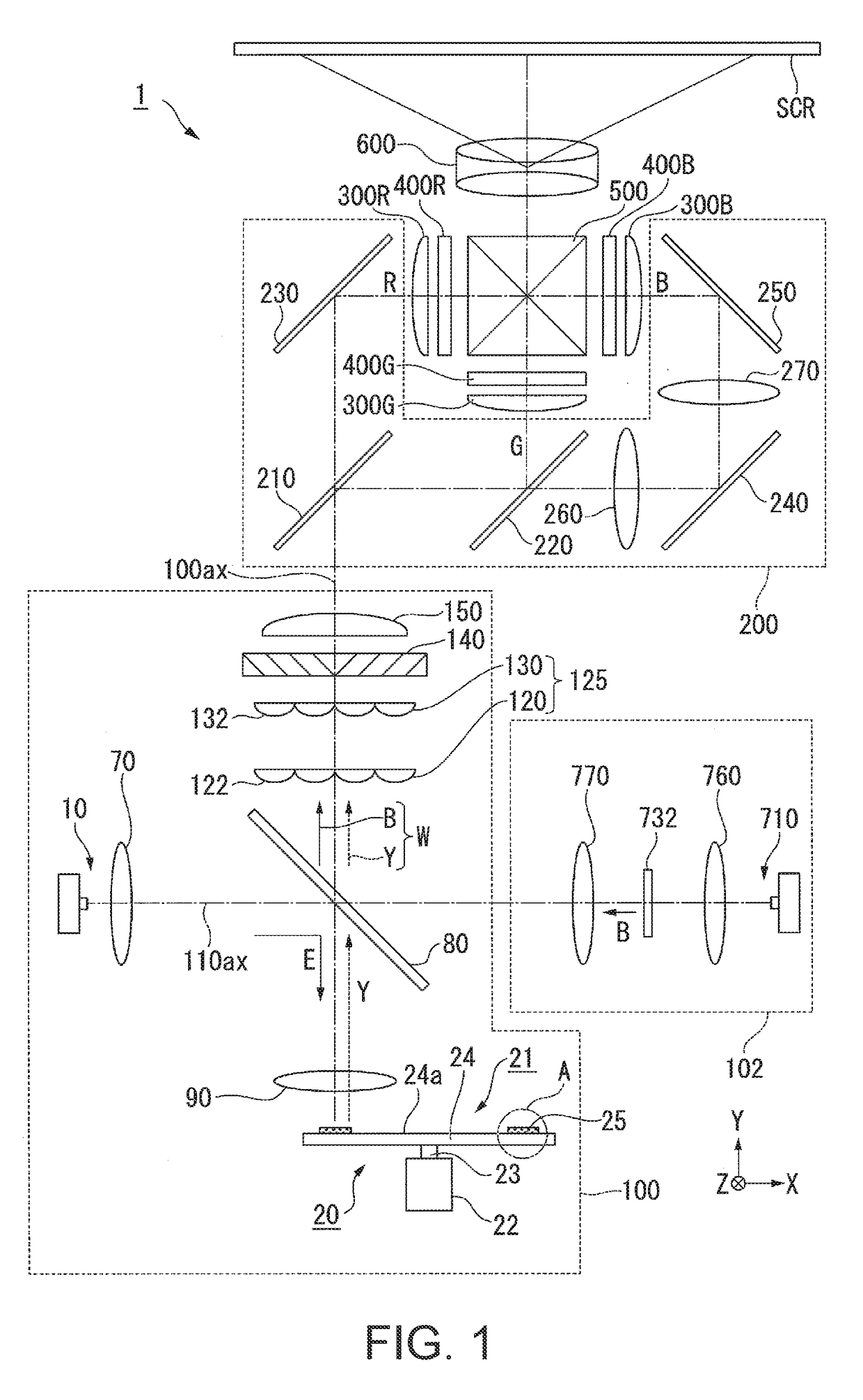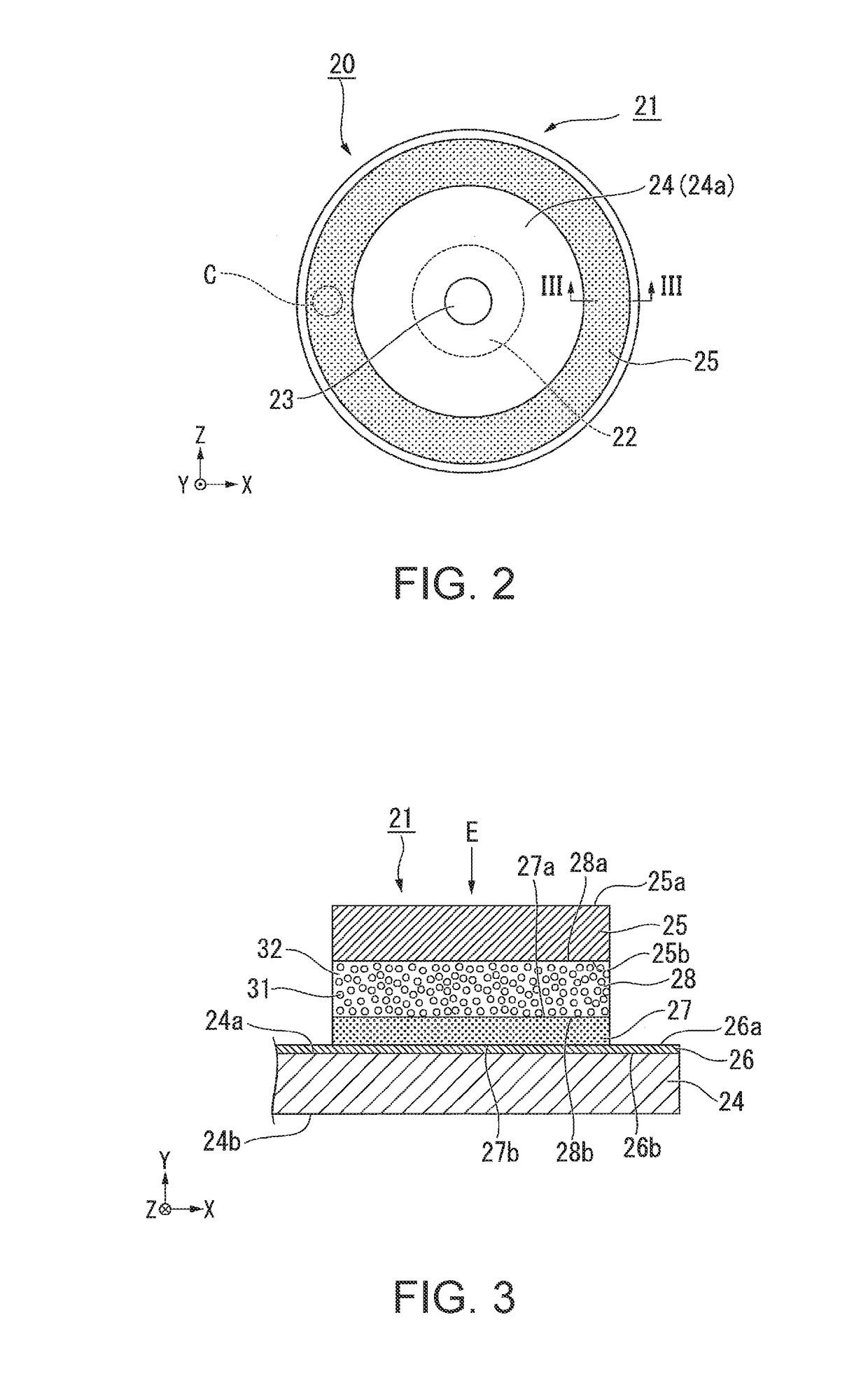Wavelength conversion element, light source device, and projector
a technology of light source device and wavelength conversion element, which is applied in the direction of projectors, instruments, optics, etc., can solve the problems of limiting the increase of reflected fluorescence, unable to obtain sufficient scattering effect, and light loss of, for example, approximately 3 to 5%, so as to achieve the effect of improving fluorescence intensity
- Summary
- Abstract
- Description
- Claims
- Application Information
AI Technical Summary
Benefits of technology
Problems solved by technology
Method used
Image
Examples
first embodiment
[0032]Hereinafter, a first embodiment of the invention will be described with reference to FIGS. 1 to 5.
[0033]A projector according to the embodiment is one example of a liquid crystal projector including a light source device including a semiconductor laser and a wavelength conversion element.
[0034]In the drawings below, components may be shown in different dimension scales for the sake of clarity of each of the components.
[0035]The projector according to the embodiment is a projection-type image display device that displays a color video on a screen (projected surface). Three light modulators corresponding to color lights: red light, green light, and blue light are used in the projector. A semiconductor laser (laser diode) capable of obtaining high-luminance, high-output light is used as a light emitting element of a light source device in the projector.
[0036]FIG. 1 is a schematic configuration diagram of the projector according to the embodiment.
[0037]As shown in FIG. 1, the proj...
second embodiment
[0106]Hereinafter, a second embodiment of the invention will be described with reference to FIG. 6.
[0107]Basic configurations of a projector and a light source device according to the second embodiment are similar to those of the first embodiment, and the configuration of a wavelength conversion element is different from that of the first embodiment. Therefore, an overall description of the projector and the light source device is omitted, and only the wavelength conversion element will be described.
[0108]FIG. 6 is a cross-sectional view of the wavelength conversion element 41 according to the second embodiment.
[0109]In FIG. 6, components common to those in the drawings used in the first embodiment are denoted by the same reference numerals and signs, and a detailed description of the components is omitted.
[0110]As shown in FIG. 6, the wavelength conversion element 41 includes the substrate 24, the reflective layer 26, a scattering layer 42, and the phosphor layer 25 (wavelength con...
third embodiment
[0118]Hereinafter, a third embodiment of the invention will be described with reference to FIG. 7.
[0119]Basic configurations of a projector and a light source device according to the third embodiment are similar to those of the first embodiment, and the configuration of a wavelength conversion element is different from that of the first embodiment. Therefore, an overall description of the projector and the light source device is omitted, and only the wavelength conversion element will be described.
[0120]FIG. 7 is a cross-sectional view of the wavelength conversion element 51 according to the third embodiment.
[0121]In FIG. 7, components common to those in the drawings used in the first embodiment are denoted by the same reference numerals and signs, and a detailed description of the components is omitted.
[0122]As shown in FIG. 7, the wavelength conversion element 51 includes the substrate 24, the reflective layer 26, a scattering layer 52, and the phosphor layer 25 (wavelength conver...
PUM
 Login to View More
Login to View More Abstract
Description
Claims
Application Information
 Login to View More
Login to View More - R&D
- Intellectual Property
- Life Sciences
- Materials
- Tech Scout
- Unparalleled Data Quality
- Higher Quality Content
- 60% Fewer Hallucinations
Browse by: Latest US Patents, China's latest patents, Technical Efficacy Thesaurus, Application Domain, Technology Topic, Popular Technical Reports.
© 2025 PatSnap. All rights reserved.Legal|Privacy policy|Modern Slavery Act Transparency Statement|Sitemap|About US| Contact US: help@patsnap.com



